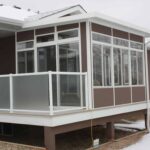How midlands weather patterns affect facility maintenance
The midlands, a region at the heart of the uk, is known for its diverse weather patterns. From wet winters to occasional heatwaves in summer, the weather in this region presents unique challenges for facility maintenance. Understanding how these weather conditions affect buildings and infrastructure is crucial for effective facilities management. This blog post will explore how midlands weather patterns impact facility maintenance, offering insights into strategies that can help mitigate weather-related issues and maintain the integrity of your facilities year-round.
1. The impact of rain and high humidity
Why it matters:
The midlands experiences significant rainfall, especially during the autumn and winter months. According to the met office, the region sees an average of 750 to 1000 mm of rainfall annually, with some areas experiencing even higher levels . High humidity and frequent rain can lead to moisture-related issues that require careful management.
Challenges:
Roof leaks and water ingress: prolonged exposure to rain can lead to roof leaks and water ingress, particularly in older buildings or those with poorly maintained roofs. Water infiltration can damage structural components, electrical systems, and interior finishes.
Mold and mildew growth: high humidity levels, coupled with damp conditions, create the perfect environment for mold and mildew growth. This not only affects air quality but can also lead to health issues for building occupants and deterioration of building materials.
Foundation erosion: continuous exposure to water can erode soil around building foundations, leading to potential structural instability. This is particularly concerning in areas with clay soils, which expand and contract with moisture changes.
Strategies:
Regular roof inspections: conduct regular roof inspections, particularly before and after the rainy season, to identify and repair any potential vulnerabilities. Ensure that gutters, downspouts, and drainage systems are clear of debris to prevent water buildup.
Humidity control systems: install dehumidifiers and ensure proper ventilation in areas prone to dampness, such as basements and storage rooms. This helps reduce humidity levels and prevents mold growth.
Foundation maintenance: monitor the soil around building foundations and consider using landscaping techniques that improve drainage, such as installing french drains or grading the landscape away from the building.
2. Cold winters and frost damage
Why it matters:
The midlands often experiences cold winters with frequent frost and occasional snowfall. While snowfall is less common than in northern regions, frost can be particularly damaging to buildings and infrastructure.
Challenges:
Freeze-thaw cycles: the freeze-thaw cycle occurs when water penetrates cracks in building materials, freezes, and expands, causing the material to crack further. This process is particularly damaging to masonry, concrete, and asphalt surfaces.
Ice dams on roofs: ice dams can form when snow on a roof melts, runs down to the colder eaves, and refreezes, causing water to back up under the shingles. This can lead to leaks and significant damage to the roof structure.
Burst pipes: prolonged exposure to freezing temperatures can cause water pipes to freeze and burst, leading to water damage and costly repairs.
Strategies:
Seal cracks and gaps: before the onset of winter, inspect the building’s exterior for any cracks or gaps in masonry, concrete, or asphalt. Seal these with appropriate materials to prevent water from entering and causing freeze-thaw damage.
Roof insulation and ventilation: proper insulation and ventilation in the attic can prevent ice dams by maintaining a consistent temperature across the roof. This reduces the likelihood of snow melting and refreezing at the eaves.
Pipe insulation: insulate exposed pipes, especially those in unheated areas, to protect them from freezing. In particularly cold weather, keep a trickle of water flowing through the pipes to prevent freezing.
3. Heatwaves and high temperatures
Why it matters:
While the midlands is not known for extreme heat, the region does experience occasional heatwaves, particularly in the summer months. According to uk climate projections, the frequency of heatwaves is expected to increase due to climate change . High temperatures can strain building systems and materials, leading to maintenance challenges.
Challenges:
Hvac system strain: prolonged periods of high temperatures can put significant strain on hvac systems, leading to increased energy consumption and the risk of system failures. Older systems may struggle to maintain comfortable indoor temperatures, especially in large commercial buildings.
Expansion of building materials: high temperatures can cause building materials like metal, wood, and concrete to expand. This can lead to warping, cracking, or loosening of joints and connections, particularly in poorly maintained structures.
Heat island effect: urban areas in the midlands can experience the “Heat island” effect, where buildings and pavement absorb and retain heat, raising local temperatures. This can increase cooling costs and accelerate wear on building exteriors.
Strategies:
Regular hvac maintenance: schedule regular maintenance for hvac systems, particularly before the summer months. This includes cleaning filters, checking refrigerant levels, and ensuring that all components are functioning efficiently. Consider upgrading to energy-efficient systems that can handle higher loads without consuming excessive energy.
Use reflective materials: incorporate reflective materials in roofing and exterior finishes to reduce heat absorption. This can help mitigate the expansion of materials and reduce indoor cooling loads.
Plant shading: use trees, shrubs, or other vegetation strategically around the building to provide natural shade, reducing the heat island effect and cooling the surrounding environment.
4. Wind and storm damage
Why it matters:
The midlands can experience strong winds and storms, particularly during the autumn and winter months. While not as severe as coastal areas, wind damage can still pose significant challenges for facilities maintenance.
Challenges:
Roof and siding damage: high winds can lift shingles, damage roofing materials, or cause siding to loosen or detach. This not only affects the building’s appearance but can also lead to water infiltration and further structural damage.
Fallen trees and debris: strong winds can topple trees or send debris flying, which can damage buildings, windows, and outdoor equipment. This is a particular concern for facilities with large grounds or those located near wooded areas.
Structural stress: continuous exposure to strong winds can put stress on the building’s structure, particularly in taller buildings. Over time, this can lead to structural weakening or failure if not addressed.
Strategies:
Reinforce roofing and siding: ensure that roofing materials and siding are securely fastened and in good condition. Consider using wind-resistant materials in areas prone to strong winds.
Tree maintenance: regularly inspect and trim trees on the property to remove dead or overhanging branches that could fall during a storm. This helps prevent damage to buildings and reduces the risk of injury.
Wind barriers: if possible, use windbreaks or barriers, such as hedges or walls, to reduce wind speed around the building. This can help protect the structure and outdoor areas from wind damage.
5. Adaptation to climate change
Why it matters:
Climate change is expected to bring more unpredictable and extreme weather patterns to the midlands, including increased rainfall, hotter summers, and more intense storms. Facilities managers must plan for these changes to protect their buildings and infrastructure in the long term.
Challenges:
Increased flood risk: with climate change, the midlands is likely to experience more frequent and severe flooding, particularly in low-lying areas or near rivers. This can cause significant damage to building foundations, electrical systems, and interiors.
Changing maintenance needs: as weather patterns shift, the maintenance needs of buildings will also change. For example, facilities managers may need to prioritize cooling systems more in the future as summers become hotter.
Strategies:
Flood prevention measures: implement flood prevention measures such as installing flood barriers, improving drainage systems, and elevating critical infrastructure above potential flood levels. Regularly review and update flood risk assessments to ensure preparedness.
Climate-resilient materials: consider using climate-resilient materials in building maintenance and upgrades. For example, materials that are resistant to both extreme heat and cold can help mitigate the effects of increasingly unpredictable weather patterns.
Sustainable practices: incorporate sustainable practices, such as using renewable energy sources or water-saving technologies, to reduce the environmental impact of the facility and increase resilience to climate change.
Conclusion: proactive facility maintenance in the midlands
The diverse and often unpredictable weather patterns of the midlands present unique challenges for facility maintenance. From managing the effects of heavy rainfall and cold winters to preparing for occasional heatwaves and strong winds, facilities managers must adopt a proactive approach to protect their buildings and infrastructure.
By understanding the specific weather-related risks and implementing targeted strategies, midlands businesses can ensure that their facilities remain safe, efficient, and resilient. Investing in regular maintenance, modern technology, and sustainable practices will not only help mitigate weather-related issues but also contribute to the long-term preservation and functionality of these essential structures.






